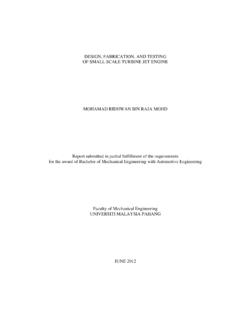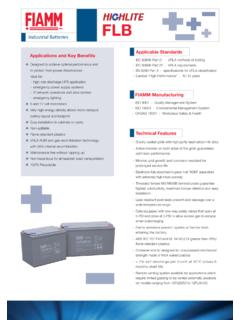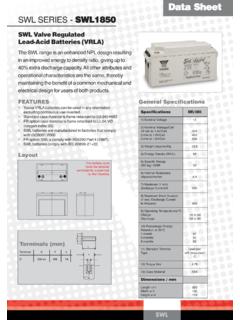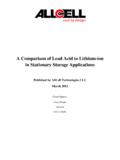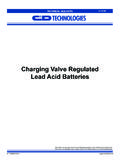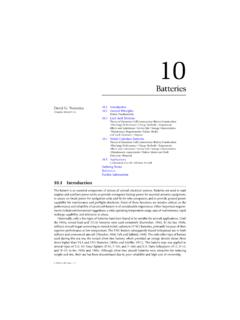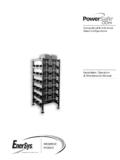Transcription of CHARGING AND DISCHARGING METHODS OF LEAD ACID …
1 CHARGING AND DISCHARGING METHODS OF LEAD ACID BATTERY MUHAMAD SYAFIQ BIN KADIRAN A thesis submitted in fulfillment of the requirements for the award of degree of Bachelor of Electrical Engineering (Power Systems) Faculty of Electrical & Electronics Engineering Universiti Malaysia Pahang 21 JUNE 2012 vi ABSTRACT Battery has played a major in many applications such as electric vehicle and uninterruptable power supply (UPS). Battery becomes a must choice because it can provide immediate power when needed. Among the battery family, lead-acid battery become a popular choice because it came in variety of output voltage and can be recharge. Although the lead-acid can be recharge, problems still occur when recharging the battery. The battery tend to undergo overcharge if the is no control mechanism to stop the CHARGING .
2 This paper represents a method of CHARGING and DISCHARGING the battery by using electronic control circuit based on the minimum and maximum voltage battery level. A NI-DAQ 6212 was introduced and configures to connect the electronic control circuit to the personal computer for display and data storage using LabVIEW. A charge and discharge program was developed to use for CHARGING and DISCHARGING purpose. The output of this project would be displaying the voltage-time graph as well as the CHARGING and DISCHARGING state of the lead-acid battery. vii ABSTRAK Bateri telah memainkan utama dalam banyak aplikasi seperti kenderaan elektrik dan bekalan kuasa uninterruptable (UPS). Bateri menjadi pilihan mesti kerana ia boleh memberikan kuasa serta-merta apabila diperlukan.
3 Antara keluarga bateri, bateri asid-plumbum menjadi pilihan popular kerana ia datang dalam pelbagai voltan keluaran dan boleh caj semula. Walaupun asid plumbum boleh caj semula, masalah masih berlaku apabila mengecas semula bateri. Bateri cenderung untuk menjalani harga yg terlalu mahal jika ada mekanisme kawalan untuk menghentikan pengecasan. Kertas kerja ini merupakan satu kaedah mengecas dan menyahcas bateri dengan menggunakan litar kawalan elektronik yang berdasarkan tahap voltan bateri minimum dan maksimum. A 6212 NI-DAQ telah diperkenalkan dan mengkonfigurasi untuk menyambung litar kawalan electronic untuk komputer peribadi untuk paparan dan penyimpanan data menggunakan LabVIEW. Satu program caj dan pelepasan telah dibangunkan untuk digunakan untuk mengecas dan melaksanakan tujuan.
4 Keluaran projek ini akan memaparkan graf voltan-masa serta keadaan mengecas dan menyahcas bateri asid plumbum. viii TABLE OF CONTENTS CHAPTER TITLE PAGE DECLARATION ii DEDICATION iv ACKNOWLEDGEMENT v ABSTRACT vi ABSTRAK vii TABLE OF CONTENTS viii LIST OF TABLES xi LIST OF FIGURES xii LIST OF ABBREVIATIONS xiv 1 INTRODUCTION Background of Project 1 Problem Statement 2 Objectives 3 Scope of Project 3 Project Outline 4 2 LITERATURE REVIEW Battery 5 Lead-Acid Battery 6 Valve-Regulated Lead Acid (VRLA) Battery 8 CHARGING METHODS 9 ix Constant Current CHARGING 10 Constant Voltage CHARGING 10 Tapered Current CHARGING 11 Combination CHARGING (Two-Step) 12 Internal Voltage Control CHARGING 13 High Current Pulse CHARGING 14 Chapter Conclusion 16 3 METHODOLOGY Introduction 17 Project Preview 17 Hardware Development 18 Relay 20 Lead Acid Battery 21 Electronic control Circuit 22 DAQ Card 23 ADVANTECH USB-4716 24 NI-DAQ 6212 24 Programming Development 26 Front Panel 27 Block Diagram 28 Wait Function 29 Terminal Configuration 29 Cut-off Limit Program 31 4 RESULTS AND DISCUSSION Introduction 32 Maximum Limit =5 and Minimum Limit =3 32 Maximum Limit =6 and Minimum Limit =3 38 Experimental Characterization of Lead Acid Battery 43 x Overcharging 43 Fully-discharge 45 5 CONCLUSION AND RECOMMENDATION
5 Conclusion 48 Limitation of the Project 49 Recommendations 49 REFERENCES 50 APPENDIXES APPENDIX A 52 APPENDIX B 53 xi LIST OF TABLES TABLE NO. TITLE PAGE Relays specification 20 DISCHARGING voltage-time 34 CHARGING voltage-time 37 DISCHARGING voltage-time 40 CHARGING voltage-time 41 Overcharging 44 Fully-discharge 46 xii LIST OF FIGURES FIGURE TITLE PAGE NO. Battery operation 6 Lead acid battery diagram 7 Different types of CHARGING METHODS 12 Variation of the internal and external voltage of test battery 14 Pulse current and charge current in DISCHARGING and CHARGING 115 Flow chart of the project 16 Electrical schematic for charge-discharge mode of lead acid battery system with details connection of relay control circuit 19 HJQ-18F-12D (8pin)
6 Relay 20 GPP645 Rechargeable Sealed Lead Acid Battery 21 Electronic control circuit connections 22 Flow chart of interfacing DAQ Card between lead acid battery And electronic control circuit 23 ADVANTECH USB-4716 24 NI-DAQ 6212 25 Front panel for CHARGING and DISCHARGING display 27 Block diagram for CHARGING and DISCHARGING program 28 Wait Until Next ms Multiple function 29 Terminal configurations for DAQ Card 29 Cut-off Limit Program 31 xiii Maximum limit =5 and minimum limit =3 33 DISCHARGING graph for maximum limit =5 and minimum limit =3 33 CHARGING graph for maximum limit =5 and minimum limit =3 36 Maximum Limit = 6 and Minimum Limit=3 38 CHARGING and DISCHARGING graph for maximum Limit = 6 and Minimum limit=3 39 Maximum limit=10 and minimum limit =1 43 Overcharging characteristic 43 Fully-discharge characteristic 45 Overcharge and fully-discharge graph 47 xiv LIST OF ABBREVIATIONS AGM - Absorbed Glass Mat GUI - Graphical User Interface DAQ - Data Acquisition DC - Direct Current USB - Universal Serial Bus NI - National Instrument PC - Personal Computer VRLA - Valve Regulated Lead Acid 1 CHAPTER 1 INTRODUCTION Background of Project CHARGING and DISCHARGING lead-acid battery is an important element to make sure that the battery can still provide power when needed.
7 CHARGING is process where the energy is being flow into the cell or rechargeable battery by forcing an electrical current through it. CHARGING a lead acid battery typically have two tasks to accomplish which are to restore the capacity as quickly as possible and to maintain the capacity compensating or self discharge. When a typical lead-acid cell is charged, lead sulphate is converted to lead on the battery s negative plate and lead dioxide on the positive plate. Over-charge reactions begin when the majority of lead sulphate has been converted, typically resulting in the generation of hydrogen and oxygen gas. At moderate charge rates, most of the hydrogen and oxygen will recombine in sealed batteries. In unsealed batteries however, dehydration will occur.. 2 To maintain capacity on a fully charged battery, a constant voltage is applied.
8 The voltage must be high enough to compensate for self discharge, but not to high as it will cause excessive over- CHARGING . The software that will be use in this project is LabVIEW. The purpose of this software is to monitor and control the voltage so that the control circuit can be switch between charge and discharge mode. Problem Statement There are some problems occur while CHARGING and DISCHARGING a battery. The problem is the CHARGING process tends to undergo overcharging because typical lead acid battery does not give signal when it fully charged. To encounter this problem, a new method of CHARGING and DISCHARGING technique is used. This method use a software that will cut-off the battery CHARGING and DISCHARGING process when the maximum and minimum voltage parameter has been set.
9 There are many types of CHARGING and DISCHARGING method use nowadays, each one of them has its own advantages and disadvantages. In this project, the method use is based on the voltage of the lead-acid battery. 3 Objectives The objectives of this project are: a) To create the CHARGING and DISCHARGING program of lead acid battery. b) To develop an electronic control circuits to control the charge-discharge process. c) To develop GUI using LabVIEW software, to record, save and monitor the voltage level and charge-discharge state. d) To experiment the characterization of lead acid battery Scope of Project In this project, a charge-discharge cycle will be created for monitor the lead acid battery voltage level. The electronic control circuit will be developed to control the charge-discharge process.
10 The output from the battery will interface by using DAQ card and monitor from the PC. The output then will be presented in voltage-time graph and charge-discharge state by using the GUI software. 4 Chapter Outline This thesis consists of five chapters including this chapter. The content of each chapter can be outlined as follows: Chapter 2 provides a literature review, background, previous research done by others researchers in the same area and relevant issues related to the CHARGING and DISCHARGING of lead acid battery. This include on overview of battery types use into scope of study. The different types of CHARGING METHODS are presented to justify the best method that use in the project. Chapter conclusion justifies the need of research on CHARGING and DISCHARGING method of lead acid battery.
